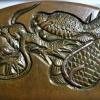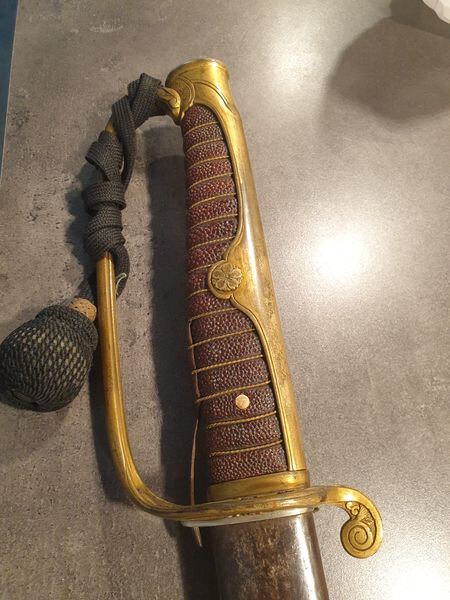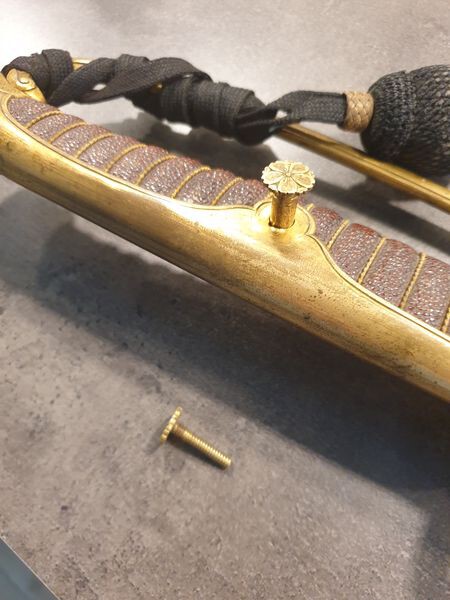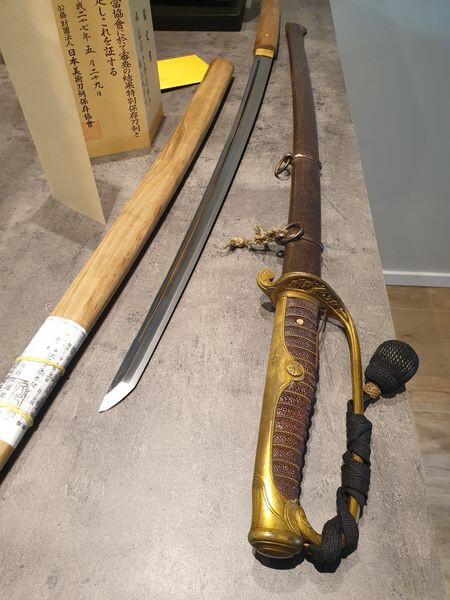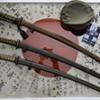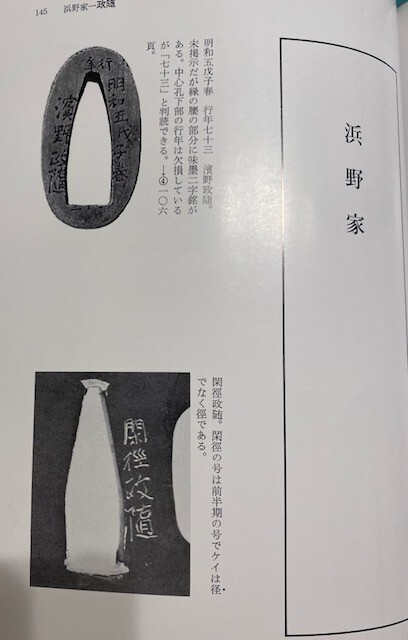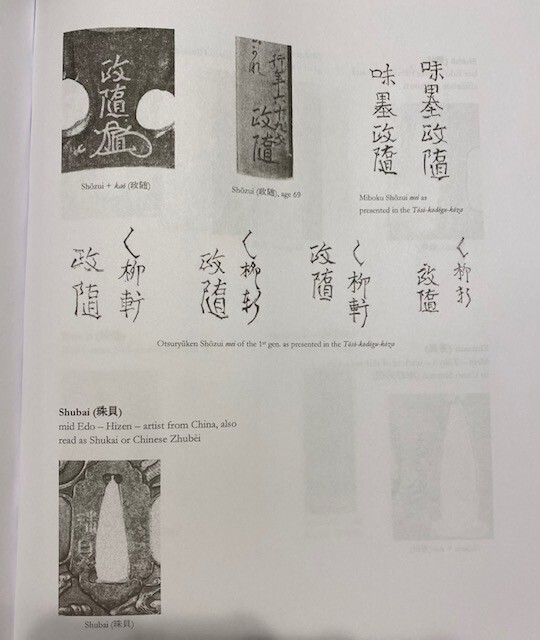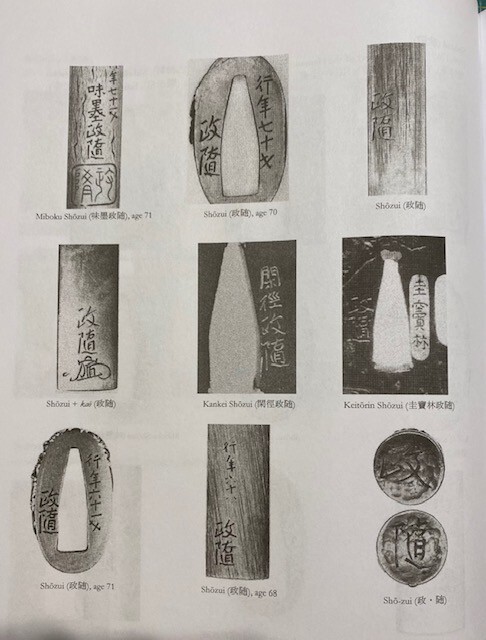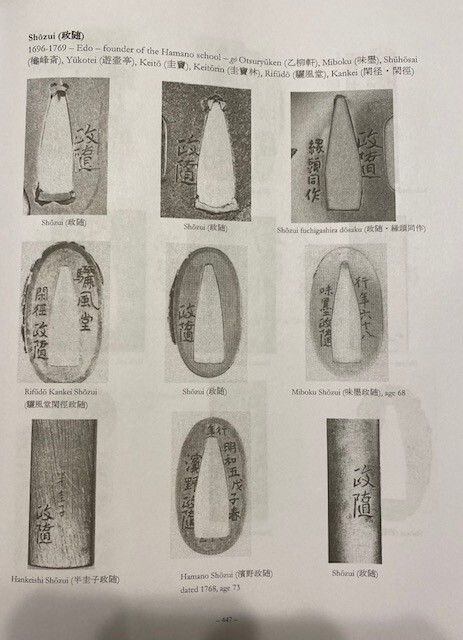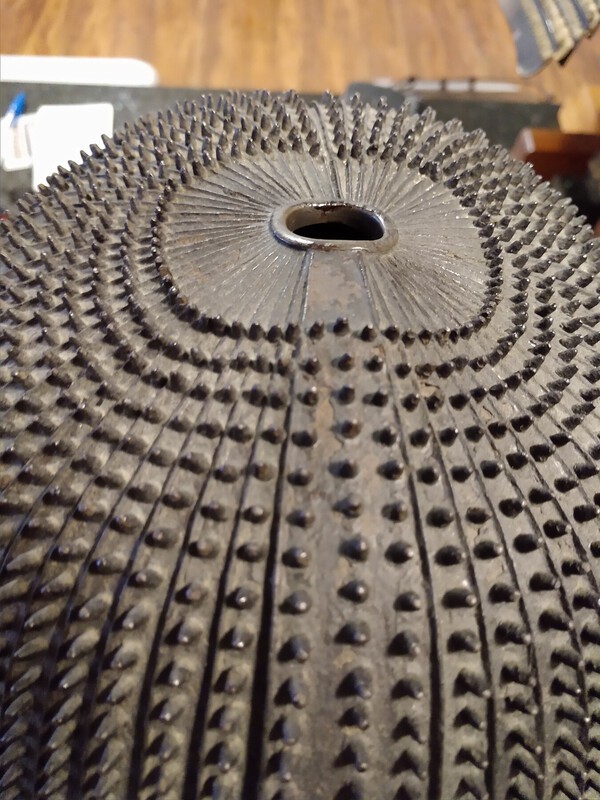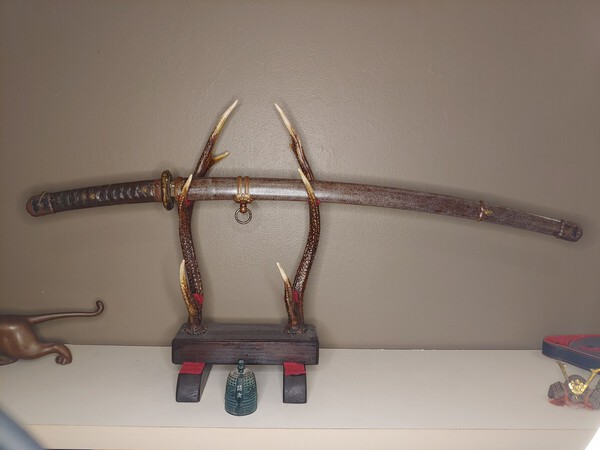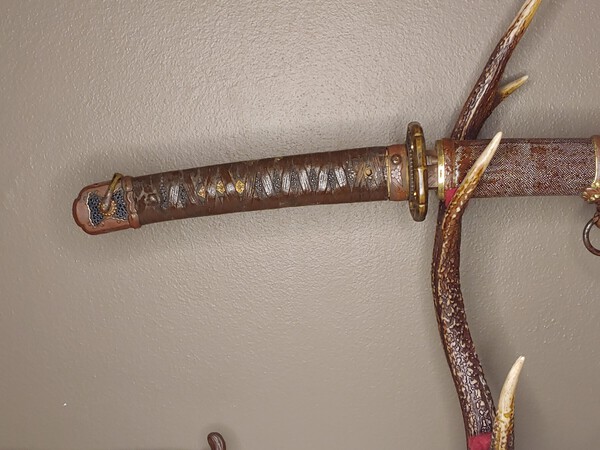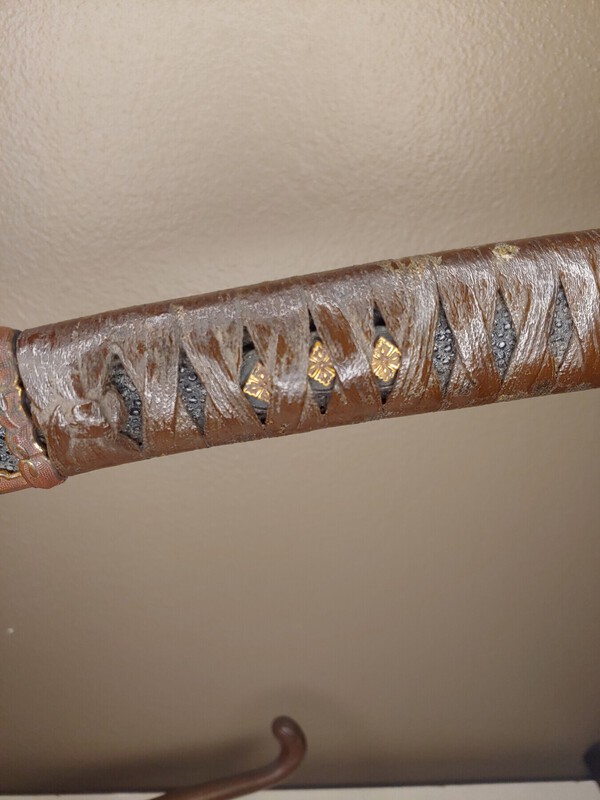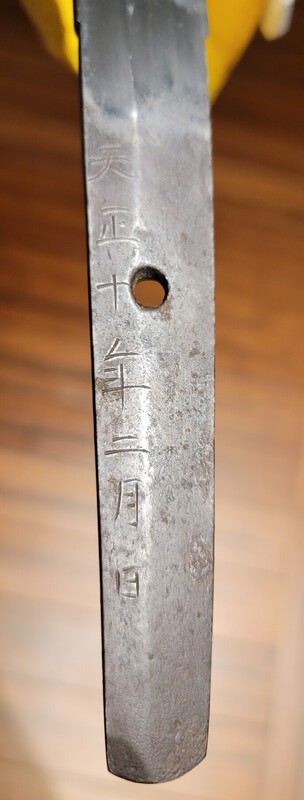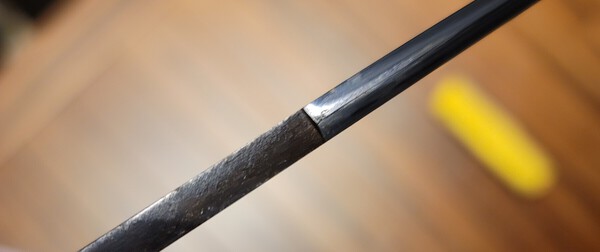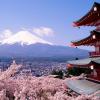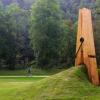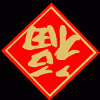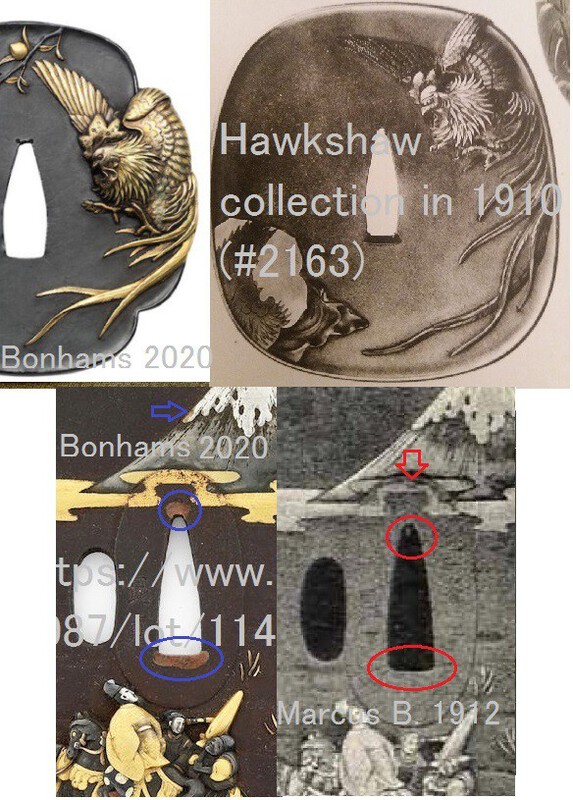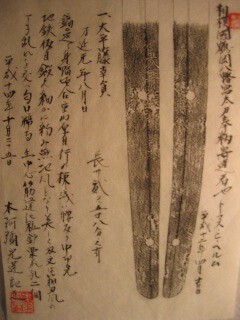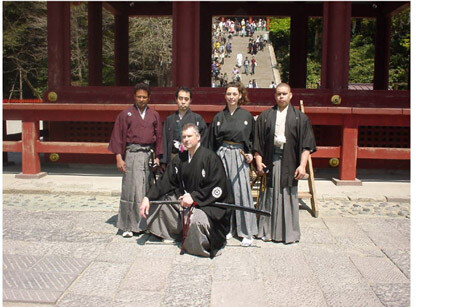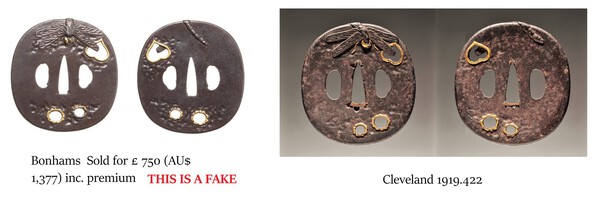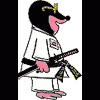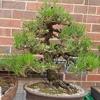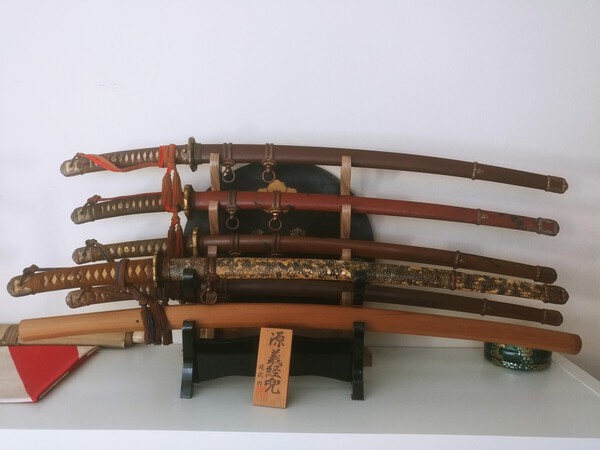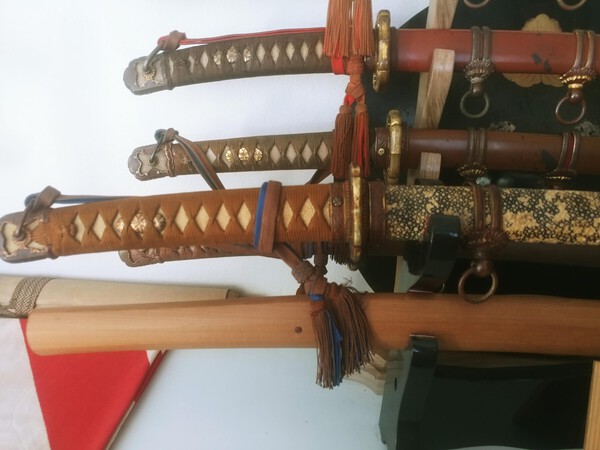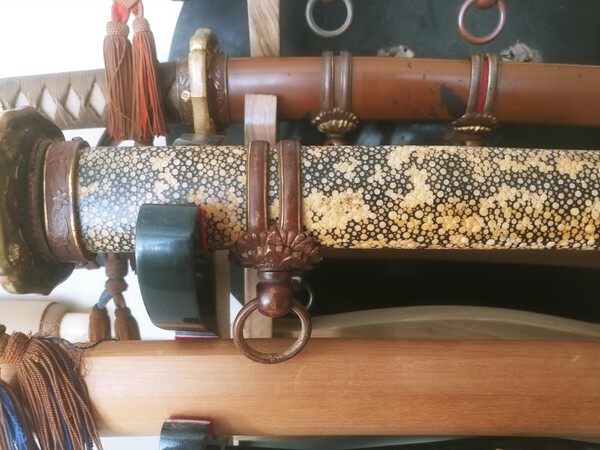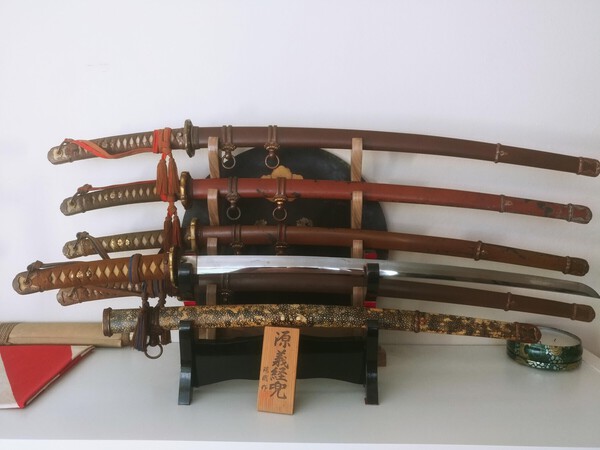Leaderboard
Popular Content
Showing content with the highest reputation on 06/05/2021 in Posts
-
According to Richard Fuller ultra rare " first pattern Warrant Officer grade Mountings,having plain backstrap, and pierced Guard. early pattern army kyu gunto use a sakura screw through the Hilt side ears plus a Mekugi peg, if a hand forged blade is used... In this case a first Gen. "Omi no kami fujiwara Tsuguhira", with TBH-Hozon, Ubu Ha and Bohi, sure a real old familie treasure....6 points
-
3 points
-
2 points
-
2 points
-
2 points
-
I don't usually handle submissions, unless it's something special that I'm interested in seeing how it works out (i.e. you found a Kiyomaro) or it's something I sold and the owner is looking to upgrade. I do those for no charge. Otherwise I point people to Bob Benson or someone else specializing in it, as it's a lot of paperwork and have to constantly be touching base with the customer and with the handler in Japan... so usually someone doing agent work like that needs to do it in bulk in order to justify the time.2 points
-
Dear Bob, re item no. 53. These two kanji can be read as "Masayuki" or "Shozui". Haynes had dozens of Masayuki but only two signing with these kanji (and he doesn't provide much useful info on them). He also has two Shozui signing with these kanji. One of them is the very famous Hamano Shozui and the other is an Ishiguro artist. Based on the style (and provenance comments), I believe that yours is intended to be Hamano Shozui. He is the founder of the Hamano School and considered as the 4th member of the Nara Sansaku (one of the four greatest artists of that time period). With respect to Shozui, Haynes says: "The majority of the signed examples seen today are forgeries, particularly the tsuba." Here are some mei from Wakayama and Sesko to compare. I hope that @Curran will comment because I believe that he has studied Shozui fairly extensively....2 points
-
2 points
-
I would say my opinion, which has a high chance of coming up wrong: a) Really o-kissaki. Surprisingly uncommon choice historically, which boxes it to either 1355-1395 or 1570-1620 (very few makers) or shinshinto. b) Matsukawa-class hada. Pretty obvious which school was being copied. b) High contrast well forged hada but hamon is very smudged and does not show standing out nie or even well grouped ko nie. It barely shows anything when looking from up down. Also the mokume has very high contrast but not so much ji nie. It does not have the nie substructure one typically sees on early Etchu work. So its someone who mixed up the steels in mokume, hardened in nie and the creation literally blew up into his face. Now he tempers in nioi, maybe allowing for ara nie in couple of areas. There were some Norishige imitators in Nambokucho period who came close, Yamamura Masanobu - would have strong nie in hamon. One would see more choji-gunome in Naotsuna's school, more sunagashi in Nobukuni. Sanekage, Tametsugu - strongly nie based hamon. Uda Kunifusa - possible. He also typically makes very Yamato-like hamon without much gunome or togari, like here. So my third choice would be him. He is seldom found with o-kissaki and hamon has strong visible "belts". Either tired/did not photograph well or its not Uda. There were also good Norishige reenactors in Momoyama-Kanei and even Kambun period (Noritoshi), but I don't remember any of them doing such long kissaki. Some are a bit similar to this style though. Then, in shinshinto mixed up steel and tempering to pure nioi was a trademark of the entire Norishige rediscovery movement, though they often referenced Go rather than Norishige per se. Ikkansai Yoshihiro was likely style's founder, than it went into Naotane's remote lineage through quite a few of his "grandstudents".2 points
-
2 points
-
Just getting back from overseas and seeing this thread now. With the swords being described, Kaneyuki, Naoe Shizu, shodai Tadayoshi special ordered by the Nabeshima daimyo, etc this sounds much like a collection we discussed here earlier. My apologies if I am mistaken.2 points
-
2 points
-
Hello, Time to change the atmosphere and open fresh air for my new acquisitions so here it goes. It isn't papered However I guarantee Hozon as it is or your money back. I am here for the long haul so definitely not looking to pull a fast one. The blade has no loose hada, no rust and IMHO a Japanese trained togishi probably wouldn't need to go back many stones to make it pristine. I see an amazing o gunome hamon and tightly kniw hada throughout and the boshi is still well preserved. No , this is Not kazu uchi mono judging by many factors. Also, many know that thin gasane was a trait for Sukesada at that period so as you may see not much has been 'shaved' off. I think it is a great and healthy blade that needs minimum to be pristine once again. Nagasa: 18" Motogasane: 5.1mm Mihaba: 27 mm Sakihaba: 22mm 2500 obo plus PP. Free shipping in the ConUS Cheers, John1 point
-
Hi! My believe is that this kabuto is not typical for Bamen school. The iron hachimanza is rather large compared to the general size from the Bamen. The mabesashi is not typical for Bamen koboshi of the period (could be a replacement). The koboshi should be more conical. There is no gunbai pattern typical for Bamen koboshi (few exeptions are extant). The harai date doesn’t feel right. Lovely old kabuto but I think the origin is from somewhere else. Nice find. Anthony1 point
-
1 point
-
1 point
-
1 point
-
1 point
-
1 point
-
1 point
-
Uwe might be right, logically. Artistically though, they are too squashed up for proper balance. Besides, the Soyo 宗世 signatures that I have managed to find, are quite different in style. Many later artists are not listed in the old books, so sometimes the line of least resistance is to assume someone from a school, or emulating the style of that school. The other possibility is a later, added signature to give an extra je ne sais quoi.1 point
-
1 point
-
Yes Piers (and Luc), early Edo is a save bet! What might speak for Bamen are the simple iron tehen-no-kanamono and the three rows of rivets on the front plate. The shape of the rivets, on the other hand, is not typical Bamen school. Although there is (at least) one helmet by the hand of “Masayuki” with similar hoshi....so further discussion is needed! Hard to tell from the pics if the shikoro (with “副” on the fukigaeshi) is a later addition or refurbished in Edo times. The ressei-bō, however, seems to be mid/end Edo.... PS: Maybe it’s only the picture, but the longitudinal axis of the construction seems not clean?!1 point
-
1 point
-
1 point
-
Ikkansai group, shinshinto the habaki moto looks way to clean, no waisting from polishing. but iv neither handled both groups1 point
-
1 point
-
It would not be so bad if they were marketed as 'replicas' [and priced that way] and these are not utsushi which would be a compliment to the original, these are deliberate fakes meant to deceive. It is a very interesting hobby isn't it !1 point
-
1 point
-
Dale, it's exactly as you said. This makes your discovery the third, no doubt about it that someone is making a mold from a picture. Buyers can buy a file that removes burrs, and then they can complete their tsuba and enjoy the self-satisfaction of owning a museum piece and the same type product. If it is made in Japan, it will be repeatedly found in online auctions. Maybe it is made in a foreign country?1 point
-
1 point
-
I do believe the gap between Tokubetsu Hozon to Jūyō is exponentially more difficult than achieving Tokubetsu Hozon from Hozon. A while back I did run some potential statistics about the numbers of swords that had passed any given level by modern NBTHK classification. While they are not 100% correct it can give some idea about the numbers of swords with each level of classification. Can you post details on the signed Kaneuji? The potential Shizu naginata you posted a picture of, is it a naginata or a naginata-naoshi? I would love to hear more details about the Uda tachi.1 point
-
A Gift to Hachiman・or how NOT to conserve a sword “TSURUGAOKA HACHIMANGU ; Famous temple located at Kamakura, dedicated to the god of war-in 1103 Minamoto Yoriyoshi had erected a temple on Yui-ga-Hama, dedicated to Hachiman, the titular god of his family. Yoritomo transported it (1193) to Kamakura and erected it on the Tsurugaoka hill, where it may be seen to the present day. In 1219 the Shogun Sanetomo went there in great pomp to render thanks for his nomination to the dignity of udaijin. After the ceremony, on descending the steps, his nephew, Kugyo, assassinated him. In 1526 Satomi Yoshihiro, the governor of the province Awa plundered the treasures of the temple but Hojo Ujitsuna obliged him to retreat.- The temple of Tsurugaoka is one of the last remnants of the grandeur of Kamakura. Interesting souvenirs of the middle ages are kept in it.” - E. Papinot The layout of Kamakura today is dominated by Wakamiya Oji, the main street in town, which runs dead straight from the beach to the Tsurugaoka Hachimangu Shrine. It was built by the order of Yoritomo, when the Tsurugaoka Hachiman shrine was erected. Moto Hachiman, or the former Hachiman is not far from my house near Zaimokuza beach. There are three Torii that stand over the road to the shrine from Ni no Torii to Ichi no Torii, which stands at the entrance to the shrine grounds; there is a raised path, which is contained within sloping stone walls like a castle. There are cherry trees set all along this path: the Dankazura. It actually tapers down to about a half its width at the shrine end, but due to an engineered optical illusion, it does not appear so. It seems Yoritomo built everything in the town with an eye to warfare; an invading army might charge down this welcoming path four or five across only to find themselves fighting in space wide enough for only two or three. April is the time to don your kimono and stroll the Dankazura enjoying the cherries in bloom. Yoritomo built the Tsurugaoka Hachimangu in fulfillment of a promise he made at the Moto-Hachiman, “should I be successful in my campaign against the Taira, I will build the biggest Hachiman shrine Japan has ever seen right here in Kamakura”. As we all know, the first Shogun’s prayers were answered, and thereafter many people high and low made offerings in thanks for the favors bestowed upon them by the spirits of this beautiful place. For some four hundred years, the storehouse of the shrine collected treasure until in 1526, during the13th battle of Kamakura,・the aforementioned Satomi Yoshihiro caused the destruction of the temple. What wonderful things were lost, we might never know, but there are as yet interesting souvenirs of the middle ages kept here. Kobizen Masatsune tachi, Kokuho Bizen Nagamitsu tachi, Juyo Bunkazai Kuniyoshi tachi, Juyo Bunkazai Soshu Tsunahiro tachi, Kanagawa ken Juyo Bunkazai Tsunaie tachi, Kanagawa ken Juyo Bunkazai Hirokuni tachi, Kanagawa ken Juyo Bunkazai Kunimura, Senjuin, Chikuzen Nobukuni, and Muramasa, all number among the one hundred or so swords that are still in the storehouse of Hachimangu. Hojo Ujitsuna, the 8th, 9th, and 10th Tokugawa Shoguns and the Meiji Emperor are some of the more notable persons making offerings here. It is the ultimate in presumption to consider myself among their number, but the fact remains that late last year I, too determined to present a sword to the shrine. Last year, I retired my Iai-to and though I felt it didn’t need a polish, I decided to do my bit for the Japanese economy and have it polished and put it in a fresh shirasaya. Unfortunately, as sometimes happens, the kawagane proved too thin and the shingane was exposed during polish, to be expected perhaps with a Kamakura period tachi but the mark of death for a shinshinto blade which mine happened to be. I now had a considerable investment in a sword which had cost me too much already and there was certainly no way for me to recover any of the money spent. I resolved therefore to lovingly preserve it as it had near been a very part of my body daily for close to ten years. In the event of my passing on, on some long distant future day, it could be treasured in my family as an heirloom. Reflecting upon the loose hold my family now has on reality and the sheer lack of interest in things Japanese they exhibit, I began to have my doubts about future generations the more I thought about it. How then to conserve this blade in a way I could be reasonably assured it would not be mistreated in the future. As you must have guessed, I hit upon the brilliant idea of donating the sword to the Hachiman shrine. Owing to the poor condition of the blade, I felt it would surely be rejected by the priests. To my surprise Hon’Ami Koji Sensei, my iai teacher, a sword polisher and conservator of the Hachiman shrine sword collection was delighted with my idea. In fact he sat down and immediately started working on a schedule for the presentation. April, 2001 was determined to be the best time so we set things in motion to carry out our Ho-no-shiki or offertory ceremony. What sword you ask is worth all this. It is not at all special, I assure you. Signed OHIRA TO YUKISADA, Dated MANEN GANNEN HACHIGATSU HI. It is a 2 shaku 5 sun 8 bu katana with chu kissaki, shallow koshizori, tight tight itame hada and a rather wide choji midare hamon. The nakago is 27cm long with kurijiri and kattesagari yasurime with kesho yasuri. The gojimei is located in the shinogiji, midway between the mekugi-ana and the habaki moto. There are 2 mekugi-ana, one of which is a shinobi-ana, which was a popular addition in the Bakumatsu era. Ohira Yukisada or Yukikazu is listed as a Musashi area smith who worked around the time of the Meiji restoration or a little before. He styled himself Yu no shin・or bird of progress・ The To (藤) in the signature is also read Fuji・as in Fujiwara so this is an abbreviation. The year 1860, Manen gannen, started out with the assassination of the great elder II Naosuke, by a group of Mito ronin, angered by his policies of placating the foreign powers and punishing those who opposed him including the lord of Mito. The country was taking sides for a battle many were certain was soon to come, one has to wonder which side of the conflict this blade was destined for. This sword was originally purchased at the Great Western Gun Show, at the San Francisco Cow Palace sometime before 1983 for $700. At that time it was in shirasaya with late Edo/Meiji period copper habaki, iron tsuba, iron fuchikashira, a blue linen wrapped tsuka with white same and menuki which had been stripped by the owner prior to me. I bought it in 1987 in this condition. There is perhaps some justice in this sword finding peace back in Japan after the abuse it suffered in America. I immediately sanded down the shirasaya and painted it with green auto-lacquer. Then began the years of swinging, whacking and cutting. Over time I had a new saya made and rebuilt and rewrapped the handle. Now it has a new silver habaki, shirasaya and proper Japanese polish. On a gorgeous Saturday in April some thirty members of the Kamakura Iaido Kyokai and guests gathered at the Hachimangu Shrine. Dressed in formal montsuki and hakama We collected in the maeden, on the same stage that Shizuka Gozen stood upon as she plead for Yoshitsune’s life in song. We bowed before the priest where receiving his blessing we presented for all the gods and buddhas to see, the faithful sword which had seen me through three thousand days of determined practice. Following this, myself and two others had their new swords blessed in a ceremony known as Nyu-kon-shiki and here upon the stage practiced for the first time with those swords. The swords used in the ceremony to be invested with the true spirit of a samurai sword were tied with mizuhiki cord, after each was blessed an attendant handed the swords to Hon’Ami Sensei who then drew his Umetada Myoju tanto and cut the cord. After which each of us presented five kata or forms to the gods of the shrine. As I took the stage to perform my forms, in each corner sat a friend acting as guard against evil, the Shitenno. In the Northeast sat Iwamura Nobuhiro, who some of you have met, 6th dan Muso Jiki Den Eishin Ryu. To the Southeast from Brazil; Candido Roberto Nunez Sequiera, 3rd dan Toyama Ryu Batto-jutsu. To the Northwest from Sri Lanka, Siri Herath, 2nd dan Toyama Ryu Batto-jutsu and in the Southwest from France, Evelyne Sentenac, Shodan Muso Shinden Ryu. Thus all the parts of the globe were represented as I drew my sword and symbolically cut down evil with my newly christened blade. Following the ceremony there was a luncheon, where I was presented with a certificate acknowledging my gift and where I was asked to give a little speech. I thanked everyone and expressed my hope that the sword would reside within the shrine as a symbol of amity between San Francisco and Kamakura, between the U.S. and Japan and persons everywhere. So now this vet pick-up old beater iaito with Mike Virgadamo saya, Russ Axt handle and wrap, Fred Lohmen menuki, Cary Condell oshigata and lacquer job by yours truly, will join the other swords in the treasure house of the great Tsurugaoka Hachimangu where it will be lovingly cared for, for perhaps another 800 years carrying with it a tale of woe all too many swords know today, along with my sincere thanks for the life changing lessons it taught me during our brief journey together and of course the dear friends it has brought me to. @Kamakura in Japan, Thomas C Helm1 point
-
That is absolutely true and is probably another nail in the coffin. I'm interested in testing the boundaries of what is "true". There are so many things that are true until they are not. When the experiment is finished, I can say "This is -confirmed- true because here are the pictures and here is the evidence." So far I have 3 first hand accounts of Cosmoline on Gunto blades: 2 say it did not stain and 1 says it does. I was hoping for unanimity. I absolutely would carry out a study of animal fat on Nihonto if I could get an appropriate, unsalvagable piece. Or cooking oil. Or anything. What if it's better? For what it's worth I'm not currently putting Cosmoline on any of my blades. They're all safely Choji oiled in the recommended way.1 point
-
Thank you very much , I am just trying to learn and hearing all comments were of a great help to me. I'm sure it would be more helpful to have the piece in hand when trying to determine who made it. I have to stick a scope down the Tehen yet to see if it is signed. Again thank you for sharing your knowledge.1 point
-
Steve, I checked my copy of John Slough's book that you have been quoting and I can't find any reference to 400 sword smiths at the 1941 exhibition.. It says "A total of 250 swordsmiths participated in this exhibition." There is also no mention of the number of people attending the exhibition, there were only 250 smiths who participated, meaning they entered blades for the competition. I think you are confusing the 1942 list of sword smiths that Kurihara Hikosaburo put together that does mention 400 smiths, but those are two different lists. Please read carefully. Kurihara's list in 1942 just lists the number of swordsmiths working that he knew about at the time, it has nothing to do with the number of smiths who entered the 1941 exhibition. It DOES NOT mean that 400 people entered the 1941 event.1 point
-
Hi Yas I have just been doing some research on a book I am about to publish on the Cleveland Museum of Art tsuba collection, and I came across this auction from 2012 https://www.bonhams.com/auctions/20190/lot/10/?category=list&length=12&page=1 There is a guard that is almost identical to the Bonhams auction one in the Cleveland Museum [number 1919.422] The only real difference is the Bonhams is a total fake! Zoom in on the hitsu-ana and it is a dead set giveaway. I feel sorry for the person who paid so much, I have a theory that many of these fakes are copied directly from museum collections on-line, in some cases the museums only show the omote side and the forgeries have to resort to a made up design on the ura.1 point
-
My second sword which I used for Iaido practice I named "Tsukiyuki" or moonlit snow. I chose this name owing to the choji-midare Hamon that looked like rolling hills of moon lit snow, and the fact that the maker of the blade was Yukisada. I was inspired by the poem "Tsukiyuki no, Naka ya, inochi no, sute dokoro" which may be rendered "The moonlit snow, is where life, is to be tossed away..." This sword was lovingly donated to the Tsurugaoka Hachimangu in Kamakura in 2001. I published an article about the whole ordeal in the newsletter of the Northern California Japanese Sword Club, it has been a while since I have revisited that article ー I believe I will post it here in its own thread for the amusement of the members.. -t.1 point
-
Interesting... I wrote a bit about this for our Iaido magazine - "Obi". The Naming of Swords by Gwyn Mowll Whilst cleaning my Nihonto the other day, I noticed how over the years I have given them all names. This was not intentional at all, it simply happened. It's very useful as well because I can reference which one is which when writing up on them and cataloguing. Some are indeed named after the smith that made the blade and I have two Gunto's (WWII Blades) named Yoshe Tsugu and KaneTsuna. The very first Nihonto I collected, an antique Chisaii Katana (Small Katana) is called Hiroda after the name written in ink on the inside of the leather combat cover that it was found in. Another Katana I have has very nice Koshirae of two friends or scholars doing various things like having tea together, so this one was named Tomodachi (Friend) because of the theme on these lovely fittings. The Koto Nambucho blade I have came with both Iai fittings and with a spare set of original Koshirae. It was originally Oshita Sensei's sword. On swinging this sword, it has a deep sultry sounding Tachi Kaze, hence I named her "Marlene" (after the singer and actress Marlene Dietrich.) The sword made by Sada Toshi is housed in magnificent Koshirae made by Ford Hallam. The Tsuba, Fuchi and Kashira depict reeds on the river whilst the Menuki are Dragonflies resting on a pebble. This riverside theme is enhanced with light green Tuka Ito and Sageo. She is called "River Song". Another Chisaii Katana I have is very old and the steel is now "tired" (probably won't take another polish) She is named O-Baa Chan (Grandmother). My iaito is called Tsugi Kage (Moon Shadow). Naming swords is not an unique thing, throughout history we have heard the legends of famous men and their swords and these swords had names. Perhaps the most famous of all is "Caledfwlch"; Arthur's sword known more famously as "Excalibur". Caledfwlch which translates from Welsh as "Hard cleft" was first mentioned in the ancient Welsh oral stories known as the "Mabinogi". These oral stories were originally the basis for Geoffrey of Monmouth's much later writings that gave birth to the Arthurian legends and it was he who gave the sword a more French sounding name hence Excalibur. Caledfwlch is described in the Mabinogi in the story called The Dream of Rhonabwy, "Then they heard Cadwr, Earl of Cornwall being summoned, and saw him rise with Arthur's sword in his hand, with a design of two serpents on the golden hilt; when the sword was unsheathed what was seen from the mouths of the two serpents was like two flames of fire, so dreadful that it was not easy for anyone to look." Most people think of Caledfwlch as a Cross hilted sword, however that design came much later and the "real" Caledfwlch probably would have been based on a Roman Spatha or Cavalry sword as it is believed that the real Arthur was a post Roman era (Romano Briton) war chief struggling to defend this land "Prydain" against the Angles, the Saxons and the Jutes. The Japanese also have their legends and the most famous sword in all of Japan's history is Kusanagi-no-Tsurugi, a sacred sword found in the tail of a slain monster which became one of the three sacred treasures. In the Tale of the Heike, a collection of oral stories transcribed in 1371, the sword is lost at sea after a naval battle.There are many other famous swords some real, some fictional that have entered the history or story books, the following being only a few: Colada and Tizona are the legendary swords of El Cid, Campeador of Spain. Zulfiqar the legendary sword of Ali ibn Abi Talib (cousin and son-in-law of the Islamic prophet Muhammad) Joyeuse - Charlemagne’s sword. Legbiter - a sword that belonged to the Viking King Magnus III. William Wallace’s sword. Honjo Masamune - The most famous of all Masamune swords is named Honjo Masamune. The Honjo Masamune is so important because it represented the Shogunate during the Edo period of Japan. The sword was passed down from one Shogun to another for generations. In 1939 the weapon was named a national treasure in Japan, but remained in the Kii branch of the Tokugawa family. The last known owner of Honjo Masamune was Tokugawa Iemasa. Apparently Tokugawa Iemasa gave the weapon and 14 other swords to a police station in Mejiro, Japan, in December of 1945. Shortly thereafter in January 1946, the Mejiro police gave the swords to Sgt. Coldy Bimore (U.S. 7th Cavalry). Since that time, the Honjo Masamune has gone missing and the whereabouts of the sword remains a mystery. Honjo Masamune is one of the most important historical artefact to disappear at the end of World War II. Gwyn Mowll Gwynedd Seiro Kan Dojo1 point
-
I named my first 2 Katanas that I bought ....after that I stopped and just starting naming my guitars after I would buy them. My first Katana was named ..... Isha 7 sutoroku It was to be poetic The Doctors 7 strokes. The old world Japanese Kanji for doctor looked like the same kanji for the number seven. The kanji strokes refer to philosophy of a sword stroke to be like calligraphy. A doctor would cut with a scalpel the size of a brush stroke. The sword steel like a scalpel.1 point
-
1 point
-
Its my %100 belief that uchiko is %100 damaging blades in polish unless done by a fully trained togi and the older I get the more this becomes obvious.1 point
-
1 point
-
1 point
-
1 point
-
1 point
-
1 point
-
1 point
-
1 point
-
1 point

